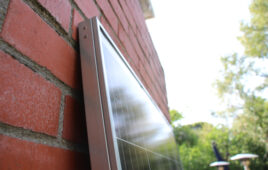A new report has determined that emissions from domestically-produced steel solar module frames are 90.4% lower than current aluminum frames manufactured in China. The independent report by Boundless Impact Research & Analytics was commissioned by steel frame startup Origami Solar.
 The data aligns Origami Solar’s steel module frames with the mission of the Ultra Low-Carbon Solar Alliance and the Global Electronics Council’s EPEAT Ultra-Low Carbon Solar Criteria to ensure that a major component of the PV supply chain is low-carbon and to accelerate embodied carbon reductions across the solar industry supply chain. This also provides a clear, data-backed alternative to carbon-intensive aluminum frames for solar module manufacturers pursuing EPEAT registration to consider.
The data aligns Origami Solar’s steel module frames with the mission of the Ultra Low-Carbon Solar Alliance and the Global Electronics Council’s EPEAT Ultra-Low Carbon Solar Criteria to ensure that a major component of the PV supply chain is low-carbon and to accelerate embodied carbon reductions across the solar industry supply chain. This also provides a clear, data-backed alternative to carbon-intensive aluminum frames for solar module manufacturers pursuing EPEAT registration to consider.
“To decarbonize solar manufacturing, we need to make improvements across the entire supply chain,” said Michael Parr, the Executive Director of the Ultra Low-Carbon Solar Alliance. “This updated assessment on Origami Solar’s steel frames for solar panels demonstrates significant life cycle carbon reductions as compared to commonly used imported frames made from virgin aluminum in China. Origami produces frames that can help solar panel producers meet the stringent carbon footprint standards in EPEAT.”
Origami Solar’s frames are produced via precision roll-forming of recycled steel, enabling localized production, higher performance and reductions in embodied carbon compared to conventional aluminum extrusion techniques predominant today. The production of the Origami Solar module frames is based in the United States and Europe, enabling less than one-day shipping to regional customers to reduce transportation and manufacturing costs and emissions.
“If we are going to curb the climate crisis, we are going to have to make educated decisions backed by hard data,” said Mike Gray, COO of Origami Solar. “The data here could not be any clearer: steel is a far cleaner option for the solar industry than the current industry-standard aluminum frames. Steel module frames are also superior in strength, durability and value than aluminum. The data has told the solar industry what it must do, namely switch to steel solar frames as quickly as possible. The only question now is whether the solar industry will listen.”
News item from Origami Solar








Kelly,
Can someone explain to me how an anodized aluminum extruded frame emits carbon in the atmosphere? I’d like to understand the science behind these claims.
You can find a deeper explanation here: https://www.solarpowerworldonline.com/2022/08/steel-is-seriously-being-considered-as-an-alternative-to-aluminum-solar-panel-frames/
But in general, it takes 13.5 MWh of thermal power to produce one tonne of aluminum (equivalent to 11.2 tonnes of CO2), while it only takes 4.5 MWh to make one tonne of steel (1.8 tonnes of CO2). And with nearly all aluminum frames coming from China, a country that relies on coal-powered electricity, solar panel frames have a dirty energy origin.